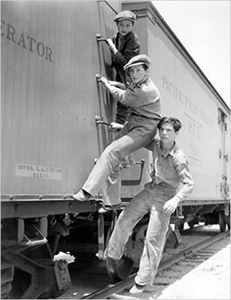Out of the Pit amplifies the negative consequences of
environmental trauma without providing any hope for rehabilitation. By
documenting the rigorous and vicious training canine ring fighters endure as
gang dogs in Chicago, these dogs have no Zen training to transform them from
deadly monster to companion species, despite serving as pets for gang members.
Combining interviews with archival footage and direct cinema, Out of the Pit reveals the torturous
process implemented to prepare dogs for battle and its long historical roots.
Dogfighting grew out of centuries of battling canines. In a brief
historical overview, the documentary explains that dogs were trained for war as
early as 3500 B.C. Mastiffs fought along with the Romans around 50 A.D. By 1100
A.D., pit dogs fought against a variety of animals, including bulls. These pit
fights continued into the nineteenth century when the British Mastiff was bred
with shorter and faster dogs. By 1835, bull baiting was outlawed, and
dogfighting took hold in Britain and the U.S. The pit bull terrier bred for
speed, tenacity, and loyalty to humans proved most adapted to the ring. The
American pit bull used in most contemporary dogfights serves as evidence of
this long history of canine soldiers. Although dogfighting was banned in most
of the U.S. in the 1970s, it is still legal to attend fights and possess
fighting dogs in some states. And the popularity of the sport in the last 20 or
so years has outpaced police response.
The sport has a
clear structure, according to the documentary, normalizing the environmental
trauma endured by the fighting dogs. The Humane Society outlines three levels
of dog fights: professional fight organizations with large kennels and training
facilities, hobbyists who may breed and sell dogs within the county and state,
and gang related street fighters who raise and haphazardly train pit bulls in
their neighborhoods. Pit bulls still are the dog of choice. They are
aggressive, loyal, and eager to please, willingly returning to battle even when
badly injured. Archival footage shows the training techniques used at the
professional level. These are elaborate and intense, with regimens that include
running on treadmills and swimming in pools and irrigation ditches, ingesting
steroids and hormones, living isolated lives to foster aggressive behavior,
developing stronger jaw muscles, and suffering dehydration to limit bleeding.
Street fighting rings emulate these techniques in miniature, training dogs more
quickly and recruiting neighborhood children to participate in the training.
Out of the Pit takes the time to show the procedure
during actual fights, as well. Although held in private homes instead of larger
facilities, street fights follow the same format as professional fights. The rounds continue
until they are no longer capable of going in for the fight. Fights usually last
for about 45 minutes but may last as long as five hours. The dogs suffer
serious injuries, of course, and they are shown in shock, dehydrated, and
bleeding to death by the end of the fights. Fight footage shows the pain and
suffering they endure.
Professionals
may treat their dogs as commodities meant to be preserved. But street fighters punish losing dogs by setting them on fire or
shooting them. Despite the contempt police officers,
veterinarians, and Humane Society officials show for these street fighters and
their torturous treatment of dogs, the documentary offers no hope for pit bulls
rescued from the ring. Instead, detailed scenes with county veterinarians
reveal that all of the dogs will be euthanized once the gang’s court cases are
settled. In Out of the Pit, the
environmental trauma faced by fighting dogs always leads to death.









